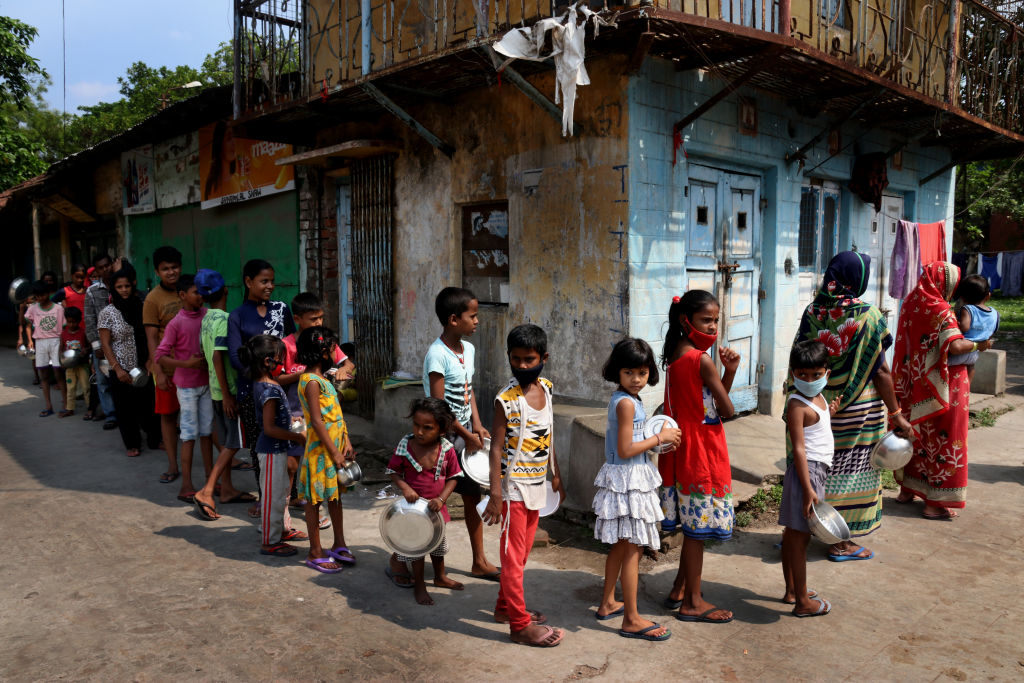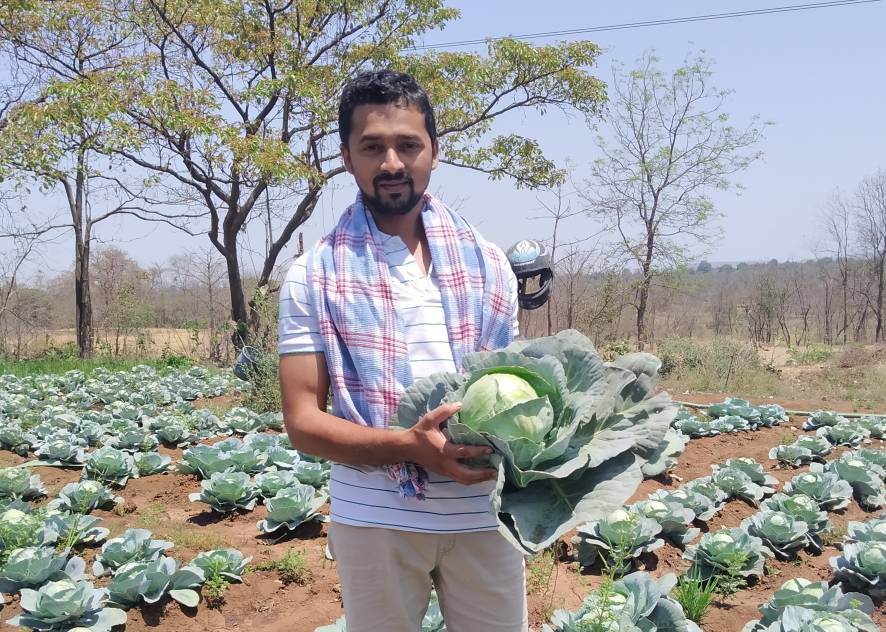
Jitendra Bangar tried to save his cabbage crop. The farmer, who lives in Bhiwandi, India, on the northeastern outskirts of Mumbai, spent the first few weeks of April spraying water on the vegetables he had harvested and stored, hoping that it would keep them fresh until he could sell them. But with strict lockdown measures in place due to COVID-19, the trader from Mumbai who normally comes to buy Bangar’s produce didn’t show up.
Bangar, 30, considered traveling the 25 miles to Mumbai himself to sell the cabbages, but he worried about catching the coronavirus and spreading it—he lives with 11 other family members, including his grandparents.
So instead, he sold some of his cabbage in the local market for a small fraction of the price it would normally fetch. He handed out the remainder of the crop to people in his village or threw it away.
“Vegetables expire fast in the heat,” he says. “A lot of it went to waste.”
Stories like Bangar’s show how the COVID-19 pandemic is profoundly disrupting the global food supply at nearly every level. Those problems, and the economic destruction caused by the virus, could have a devastating impact on the ability of people across the world to access and afford food. At least 265 million people are at risk of going hungry in 2020, according to an estimate made by the U.N. World Food Programme (WFP) in April—almost twice as many as in 2019. This is despite the fact that experts agree there should be enough food to feed the world this year.
Across the globe, harvests are going to waste because laborers are banned from working, can’t travel to farms or don’t want to work for fear of catching the virus. Meat processing plants in the U.S. have been shut down over COVID-19 outbreaks. Farmers in the U.S. and the U.K. have been forced to dump milk because demand from restaurants and coffee shops plummeted under lockdown. Transportation restrictions have made it difficult for farmers to obtain seeds and fertilizer to plant new crops, or to send the ones they harvest to local food markets, which have closed in some places. Exacerbating the problem, some countries have imposed export bans—Vietnam announced a ban on rice exports in March, though it was later lifted, and Russia announced in April a quota for wheat exports until June—blocking trade that other countries rely on to feed their people.

Then there’s the growing problem of affording food. With the collapse of the global economy, caused by lockdowns all over the world, millions who already struggled to feed their families are now facing dire situations as work dries up and jobs evaporate. And in places dependent on food imports, prices could skyrocket because of the supply chain disruptions. The tiny Pacific island nation of Kiribati, for instance, has already seen the cost of rice increase by nearly 50%.
Enough food to go around?
The world has enough food stocks, and projections show 2020 should be a good year for crops, experts say.
A commodities market report released on May 7, based on assessments by several international organizations including the U.N Food and Agriculture Organization (FAO) and the World Trade Organization, says that while soybean stocks may decrease slightly due to harvest conditions in several South American countries, wheat and corn stocks for this season will be better than last year. Rice stocks should also be about the same.
But while “global supplies of basic foodstuffs remain abundant,” the report warns that “shocks created by COVID-19 started taking a toll on food markets last month.” The question is whether the food can be harvested and sent to the right places in time.
“The issue is more about food supply disruption rather than food shortages,” Julie Howard, a senior adviser on global food security at the Washington-based Center for Strategic and International Studies (CSIS) tells TIME.
Protectionist trade policies, even temporary ones, have raised concerns about the flow of wheat and rice. A drop in oil prices, and a fall in ethanol production and feed demand, have meanwhile led to sharp drops in maize prices, according to the report.
Poorest at risk
Even before coronavirus swept across the globe, 135 million people in 55 countries faced acute hunger, mainly because of conflict, climate change and economic crises, the WFP estimated. If the pandemic is taken into account, that number nearly doubles to 265 million.
“COVID-19 is potentially catastrophic for millions who are already hanging by a thread. It is a hammer blow for millions more who can only eat if they earn a wage,” WFP chief economist Arif Husain said in a press release. “Lockdowns and global economic recession have already decimated their nest eggs. It only takes one more shock—like COVID-19—to push them over the edge.”
Many who are at risk of hunger will face more difficulty accessing food while shutdowns and movement restrictions are in place. “The food system in low-income countries is made up primarily of micro and small businesses that produce, process, market and directly sell to consumers through restaurants and street stands,” says Howard.
But even if they can access food, there are many who won’t be able to afford it. The International Monetary Fund projected in April that the global economy will shrink by 3% in 2020. The pandemic could wipe out the equivalent of 195 million jobs worldwide, according to the U.N. International Labor Organization.
Paul Teng, an adjunct senior fellow in international studies at Singapore’s Nanyang Technological University (NTU), says that he is concerned about millions of daily-wage workers all over Asia and Africa who have taken a hit to their income and have lost “economic access” to food.
Concern is greatest for people living in conflict zones and refugee camps, with countries of concern including parts of Nigeria, South Sudan, Syria and Yemen, according to the World Food Programme.
Humanitarian agencies say they are concerned that if trade flows are disrupted, they may not be able to provide aid to those most in need. “It’s critical that commercial trade continues to flow regardless of anything else taking place around it,” warns Husain. “Quite simply, millions of people’s lives depend on the flow of trade, and the impact of disruption on people’s food security is hugely concerning.”
Import reliance
Countries that are dependent on imports are also facing strain. “Net food import countries whose revenues are affected because of the recession will be seriously affected,” Máximo Torero, the chief economist and assistant director-general of the economic and social development department at the FAO, tells TIME.
Depending on how hard COVID-19 hits the global economy, 80 million people in net food-importing countries could find themselves chronically without enough food in one scenario modeled by the FAO. Under a more optimistic “mild scenario,” almost 40 million people will be affected.
Howard says that countries in Africa import over $35 billion in food annually. “Countries like Nigeria are large food importers but are now being doubly hit—by COVID-19 and by plunging oil prices, the country’s main source of revenue, decimating the government’s budget and making food and other imports even more expensive,” she says.
Price volatility isn’t helping the situation. “It’s quite unpredictable at the moment, some prices go up, some prices go down because of the restrictions and export bans,” says Nicolas Bidault, senior advisor for food security at the WFP’s Asia-Pacific office. Price fluctuations leave import-reliant countries “extremely vulnerable to risks such as price swings during a global crisis,” the WFP says.
Small Pacific island nations are of particular concern. In the middle of the South Pacific Ocean, residents of Kiribati are worried about what the future will bring. Ruiti Uriano Aretaake, a program coordinator at the local NGO FSP Kiribati says that people have started stocking up on imported items like rice, flour and sugar over fears that enough won’t be brought in—most flights to and from the island have been halted.
Prices have already gone up significantly. A bag of rice that normally sells for about $10.75 now costs about $15.65.
“We are worried about the future,” she says.
Today’s restrictions might cause food shortages in the future
Some experts are worried that disruptions occurring today could hurt the food supply in the future.
Howard of CSIS says that there is a “significant risk” that the impact on food supply could be extended if the pandemic disrupts farmers’ ability to plant and produce food during the next agricultural season.
There have already been logistical issues. In the Philippines, for example, where strict lockdown measures are being enforced, the country’s largest seed organization said in April said that seeds were getting caught at checkpoints.
An inability to plant now is a problem for regions across the world. Howard says the beginning of the next agricultural season starts in May across the tropics and sub-tropics. Most African agricultural systems are rain-fed, she says, which means that if farmers can’t prepare land and plant before the rainy season, production will likely decline for the coming season—extending the impact of the pandemic.
In Asia, where rice is a staple, April and May are important months for the grain’s production, according to Teng at NTU. He says that if planting is not done at the right time, the whole season may be in peril.
“If the lockdown continues, if ports are not allowed to ship out, if farmers cannot harvest their produce and if farmers cannot plant for their next season—there are some really doomsday type scenarios being floated around that I hope don’t turn to reality.”
What the world needs to do
At the FAO, Torero called for several actions to avoid food shortages in a paper published at the end of March, including emergency food assistance, the expansion and improvement of social protection, and support for smallholder farmers to enhance their productivity and ability to bring goods to market. (In China, for example, e-commerce platforms have stepped in to market agricultural products that may otherwise have gone unsold.) Global food trade needs to be kept open and key countries that export staple foods should try to minimize logistics disruptions, his paper says.
Some experts say the crisis may have a long lasting impact on the food supply chain. Howard says that she expects the food supply chain to shorten so that countries don’t have to rely on food being shipped across the world.
“The devastating impacts of the pandemic may provide the key impetus for leaders, the private sector and donors to expand investments aimed at developing much more productive, climate-resilient and healthy home-grown food and agricultural systems,” she says.
Bangar, the farmer from India, is hopeful for the future, despite the loss of his recent harvest. He has already started planting some eggplants. He says that when the eggplant is ready to harvest in about a month, he will try to sell the vegetables in his village if the trader from Mumbai doesn’t come back.
“Hopefully by then, things will get better,” he says. “I don’t know what lies ahead, but we are farmers and there will always be demand for food.”
—With reporting by Abhishyant Kidangoor / Hong Kong.
More Must-Reads from TIME
- Cybersecurity Experts Are Sounding the Alarm on DOGE
- Meet the 2025 Women of the Year
- The Harsh Truth About Disability Inclusion
- Why Do More Young Adults Have Cancer?
- Colman Domingo Leads With Radical Love
- How to Get Better at Doing Things Alone
- Michelle Zauner Stares Down the Darkness
Write to Amy Gunia at amy.gunia@time.com